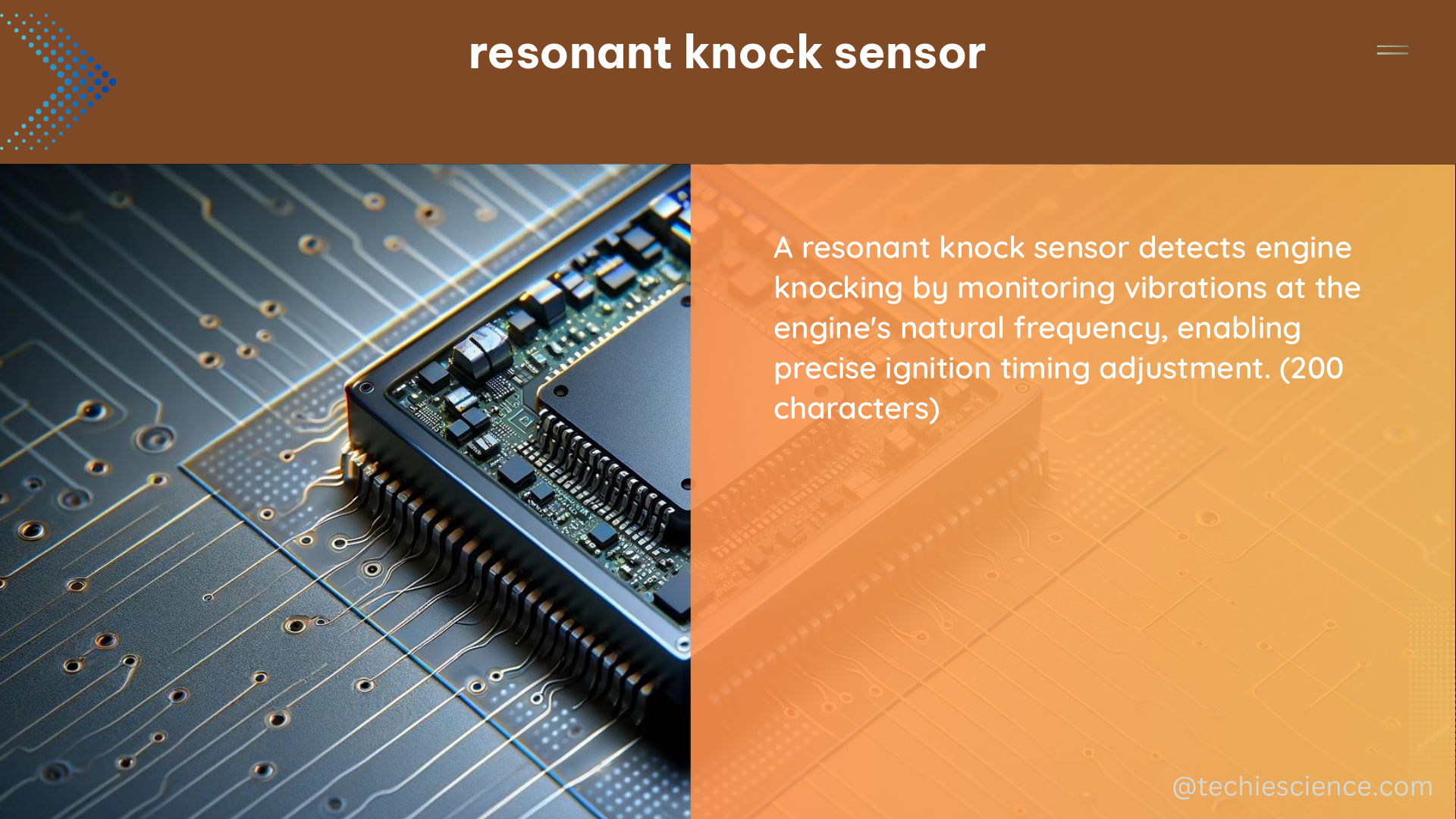The resonant knock sensor is a critical component in modern internal combustion engines, designed to detect and measure engine knock or detonation. Engine knock occurs when the air-fuel mixture in the cylinder ignites spontaneously, creating a pressure wave that can cause significant damage to the engine. This sensor plays a crucial role in monitoring and controlling engine performance, ensuring optimal efficiency and preventing costly engine repairs.
Understanding the Technical Specifications of the Resonant Knock Sensor
The resonant knock sensor typically consists of a piezoelectric sensing element that converts the mechanical stress generated by engine knock into an electrical signal. This signal is then processed and analyzed by the engine control unit (ECU) to determine the presence and severity of the knock.
Sensing Element and Frequency Response
The sensing element of the resonant knock sensor is typically made of a piezoelectric material, such as lead zirconate titanate (PZT) or barium titanate. These materials generate an electrical charge when subjected to mechanical stress, allowing the sensor to detect the pressure waves associated with engine knock.
The sensor’s frequency response range is typically between 1 kHz and 20 kHz, with a sensitivity of around 10 mV/kPa. This wide frequency range ensures that the sensor can accurately detect the high-frequency vibrations generated by engine knock, which typically occur in the range of 5 kHz to 10 kHz.
Sensor Size and Installation
The size of the resonant knock sensor varies depending on the engine application, but it is usually small enough to be installed directly in the engine block or cylinder head, in close proximity to the combustion chamber. This placement allows the sensor to effectively detect the pressure waves generated by engine knock.
The Principle of Operation: Resonant Frequency Matching

The resonant knock sensor operates by using a resonant frequency that matches the frequency of the engine knock. When engine knock occurs, the sensor’s resonant frequency changes, causing a corresponding change in the electrical signal. This change is then processed and analyzed by the ECU to determine the severity of the engine knock.
Resonant Frequency Range
The sensor’s resonant frequency is typically in the range of 5 kHz to 10 kHz, depending on the engine application. This frequency range is chosen to match the typical frequency of engine knock, ensuring that the sensor can effectively detect and respond to the pressure waves generated by the knock.
Signal Processing and Analysis
The electrical signal generated by the resonant knock sensor is sent to the ECU, which processes and analyzes the signal to determine the presence and severity of engine knock. The ECU can then adjust the engine’s ignition timing and fuel injection to minimize the knock and optimize engine performance.
Installation and Integration with the Engine Control Unit (ECU)
To install a resonant knock sensor, the sensor is typically mounted in the engine block or cylinder head, in close proximity to the combustion chamber. The sensor is then connected to the ECU, which processes and analyzes the sensor’s electrical signal.
Sensor Placement and Wiring
The placement of the resonant knock sensor is crucial for its effective operation. The sensor should be installed in a location that allows it to accurately detect the pressure waves generated by engine knock, typically near the combustion chamber. The sensor’s wiring must be routed carefully to avoid interference and ensure a reliable connection to the ECU.
ECU Integration and Knock Control
Once the resonant knock sensor is installed, it is integrated with the ECU, which processes the sensor’s electrical signal and uses it to adjust the engine’s ignition timing and fuel injection. This allows the ECU to minimize engine knock and optimize engine performance, improving fuel efficiency, power output, and engine longevity.
Maintenance and Troubleshooting
Like any other automotive component, the resonant knock sensor requires regular maintenance and inspection to ensure its proper functioning. Regular checks for sensor damage, wiring issues, and proper ECU integration are essential to maintain the sensor’s reliability and the engine’s overall performance.
Sensor Inspection and Replacement
Periodically, the resonant knock sensor should be inspected for signs of wear, damage, or degradation. If the sensor is found to be malfunctioning, it should be replaced with a new, compatible unit to ensure accurate knock detection and engine protection.
Troubleshooting Knock-Related Issues
In the event of engine knock-related issues, the resonant knock sensor’s performance should be thoroughly evaluated. This may involve checking the sensor’s electrical connections, verifying the ECU’s knock control algorithms, and potentially performing diagnostic tests to identify the root cause of the problem.
Conclusion
The resonant knock sensor is a critical component in modern internal combustion engines, playing a vital role in monitoring and controlling engine performance. By understanding the technical specifications, operating principles, and installation requirements of this sensor, engine enthusiasts and technicians can ensure optimal engine performance, efficiency, and longevity.
References:
1. Genetically Encoded Fluorescent Biosensors Illuminate the Mechanisms of Cellular Signaling Pathways. NCBI, 14 Dec. 2018, https://www.ncbi.nlm.nih.gov/pmc/articles/PMC7462118/.
2. HeartMath Considered Incoherent. Slate Star Codex, 17 Jul. 2014, https://slatestarcodex.com/2014/07/17/heartmath-considered-incoherent/.
3. Analysis Techniques for Race Car Data Acquisition. Academia.edu, 2016, https://www.academia.edu/88089423/Analysis_Techniques_for_Race_Car_Data_Acquisition.
4. 2021 Owens Corning Sustainability Report. Owens Corning, 2022, https://www.owenscorning.com/en-us/corporate/sustainability/docs/2022/2021-Owens-Corning-Sustainability-Report.pdf.
5. 2024 Roadmap on Magnetic Microscopy Techniques and Their Applications. arXiv, 10 Jan. 2024, https://arxiv.org/pdf/2401.04793.

The lambdageeks.com Core SME Team is a group of experienced subject matter experts from diverse scientific and technical fields including Physics, Chemistry, Technology,Electronics & Electrical Engineering, Automotive, Mechanical Engineering. Our team collaborates to create high-quality, well-researched articles on a wide range of science and technology topics for the lambdageeks.com website.
All Our Senior SME are having more than 7 Years of experience in the respective fields . They are either Working Industry Professionals or assocaited With different Universities. Refer Our Authors Page to get to know About our Core SMEs.